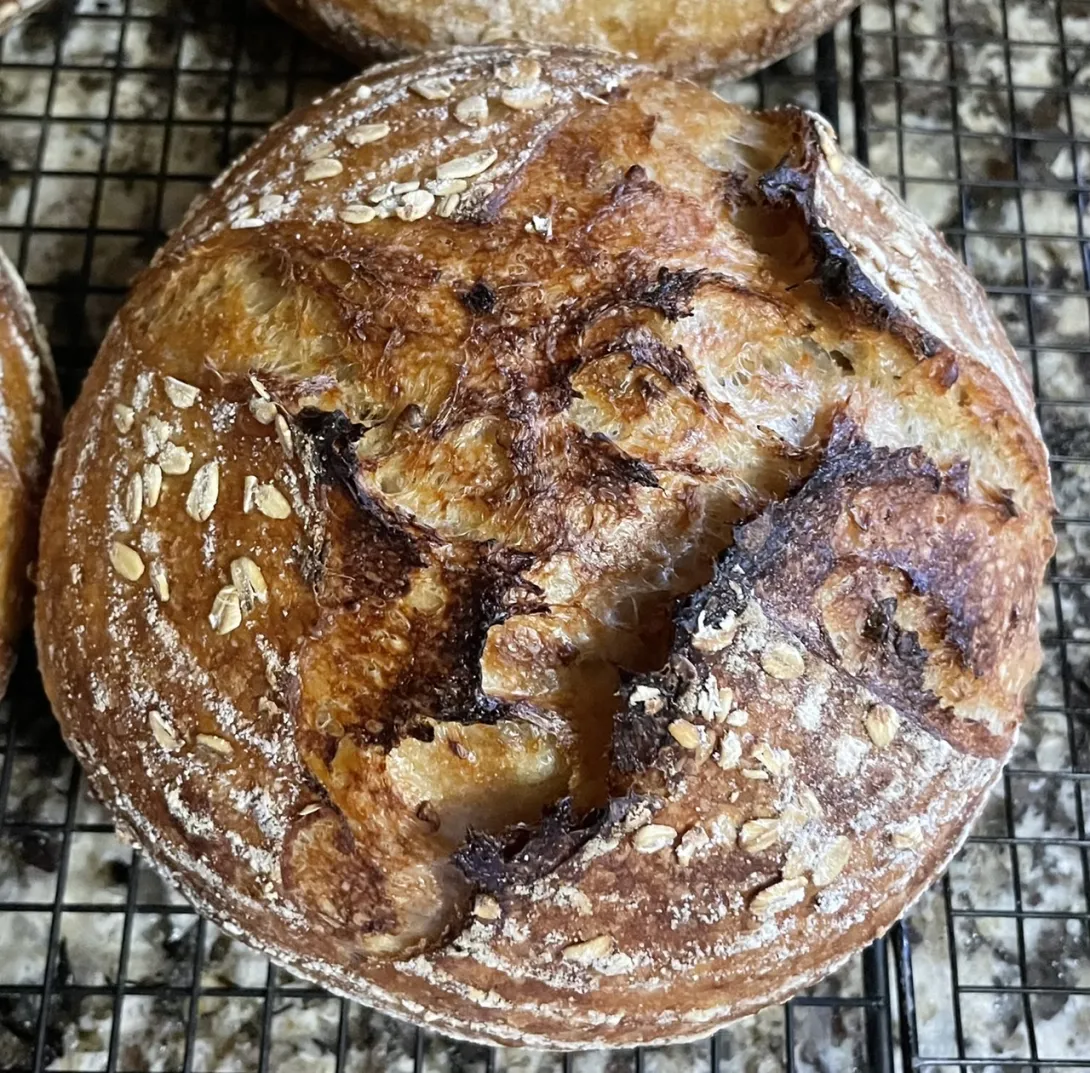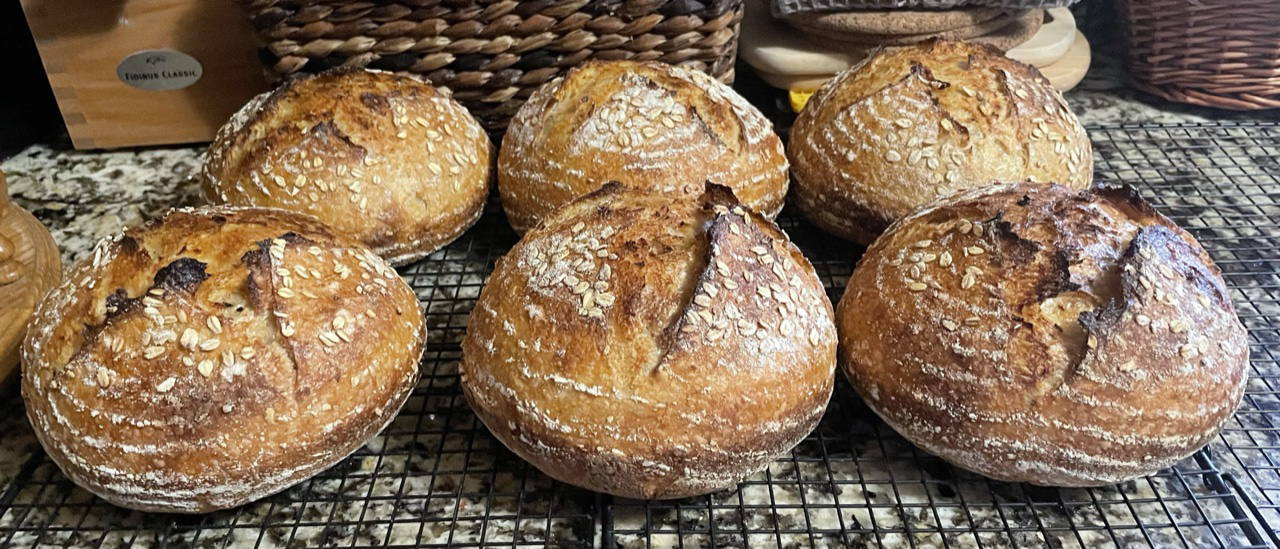
This is one of my very favourite breads. It is so creamy and delicious.
On another note, a couple of my breads in the last few weeks crashed and burned as far as I was concerned. The dough overproofed and started falling apart when I went to shape it. Both of these doughs had dried fruit in them but these are recipes that have been successful in the past so I became suspicious that my starter was going proteolytic. I’ve been very lackadaisical in feeding the starter in the fridge. I used to keep it very thick but for a while now, I’ve been tossing in left over levain from my baking instead of giving it a proper feeding. It tasted extremely acidic and was quite runny.
I read up on proteolytic starters and I am trying to get it back into balance. I’ve been discarding 50 to 90% of the starter and feeding it a bit of wholegrain flour with the majority being unbleached flour. I’ve been doing mostly 1:2:2 feeds with one 1:5:5 feed at the beginning to try to get rid of a lot of the acid. I’ve been doing at least two feeds a day at room temperature, and feed as soon as I feel the starter peaked which is when it’s about triple in volume. As per Mini Oven in her posts, I’ve been tasting the starter and the acidity has definitely improved over the 6 days I’ve been doing this. The texture has improved as well as now I see gluten strands rather than just liquid cake like batter. I’ll continue for another week but I did use it for this bake to see where we are at.
Finger crossed that this will help!
Recipe
Makes 3 loaves
Porridges:
50 g large flake oats and 150 g water
50 g coarse milled Khorasan and ~200 g water
Dough:
300 g fresh milled Khorasan (Kamut) flour (300 g Kamut berries)
700 g strong bakers unbleached flour
700 g water
23 g pink Himalayan salt
30 g yogurt
250 g levain (procedure in recipe)
Whole grain and AP flour to feed levain
Flaked khorasan and oats for topping
The afternoon before:
- Take 2 g of refrigerated starter and feed it 4 g of filtered water and 4 g of any kind of wholegrain flour. Let sit at cool room temperature for the day.
The night before:
- Mill the Khorasan berries and place the required amount in a tub.
- Add the unbleached flour to the tub. Cover and reserve.
- Mill the khorasan berries for the porridge and set aside for the morning.
- If you wish, you can cook the porridges now and refrigerate overnight. Take them out of the fridge a couple of hours prior to mixing the levain with the dough.
- Before bed, feed the levain 20 g of water and 20 g of wholegrain flour. Let that rise at cool room temperature for the night.
Dough Making day:
- In the morning, feed the levain 100 g of filtered water and 50 g of whole grain flour and 50 g of unbleached flour. Let rise in a warm place until doubled (about 5 hours). Mine almost tripled during that time so maybe the work I did with the starter paid off.
- About 2 hours before the levain is ready, put 700 g filtered water in a stand mixer’s bowl and add the flours from the tub. Mix on the lowest speed until all the flour has been hydrated. This takes a couple of minutes. Cover and autolyse for 2 hours at room temperature (73F).
- Add the water to the rolled oats and cook on low, uncovered, until very thick and creamy. All the water should have been absorbed. Set aside to cool.
- Do the same with the coarse ground Khorasan and the water. I started with 100 g of water and found out fast that this needed to be watched closely. Mine started sticking after 15 minutes so I added about another 100 g of water. It took about 25 minutes to soften the khorasan. In the past, this has taken up to 45 minutes. Add to the oat porridge and let cool.
- After the autolyse, add the salt, the yogurt, the porridges, and the levain to the dough. Mix on the lowest speed for a minute to integrate everything, then mix on the next speed for 9 minutes.
- Remove dough from bowl and place in a lightly oiled covered tub. Let rest in a warm spot to begin bulk fermentation. My warm spot is the oven with the door cracked open and the lights on. I get an ambient temperature of around 82F.
- Do 1 set of coil folds after 30 minutes and then 3 sets of coils folds at 45 minute intervals. Then let the dough rise by 30%. Total bulk was about 3 hours and 15 minutes.
- Tip the dough out on a bare counter, sprinkle the top with flour and divide into portions of ~775 g. Round out the portions into rounds with a dough scraper and let it rest 20 minutes on the counter.
- Do a final shape by flipping the rounds over on a lightly floured counter. Gently stretch the dough out into a circle. Pull and fold the third of the dough closest to you over the middle. Pull the right side and fold over the middle and do the same to the left. Fold the top end to the center patting out any cavities or big bubbles. Finally stretch the two top corners and fold over each other in the middle. Roll the bottom of the dough away from you until the seam is underneath the dough. Cup your hands around the dough and pull towards you, doing this on all sides of the dough to round it off. Finally spin the dough to make as tight boule as you can.
- Sprinkle some large flake oats in the bannetons. If your bannetons are not well seasoned, sprinkle rice flour first, then the bran and the oats. Place the dough seam side up in the bannetons. Cover with plastic bowl covers or shower caps. Let rest for a few minutes on the counter and then put to bed in a cold (38F) fridge overnight.
Baking Day
- The next morning, heat the oven to 475 F with the Dutch ovens inside for an hour.
- Turn out the dough seam side down onto a cornmeal sprinkled counter. Score dough. Place rounds of parchment paper in the bottom of the pots, and carefully but quickly place the dough seam side down inside.
- Cover the pots and bake the loaves at 450 F for 25 minutes, remove the lids, and bake for another 22 minutes at 425 F. Internal temperature should be 205 F or more.
Well it looks like my suspicions were correct. These definitely got decent oven spring! I’m going to keep my starter on the counter for the next week and keep doing the discard and feed when at peak to ensure maximum strength and reduction of those proteolytic enzymes.

- Danni3ll3's Blog
- Log in or register to post comments
These definitely have better oven spring Danni, I’m sure you were correct in your thinking about your starter health.
I got too complacent about keeping it in the fridge. I’ve changed it to be mostly unbleached flour for now to get the yeast up and lower the enzymes.
Nothing to complain about!